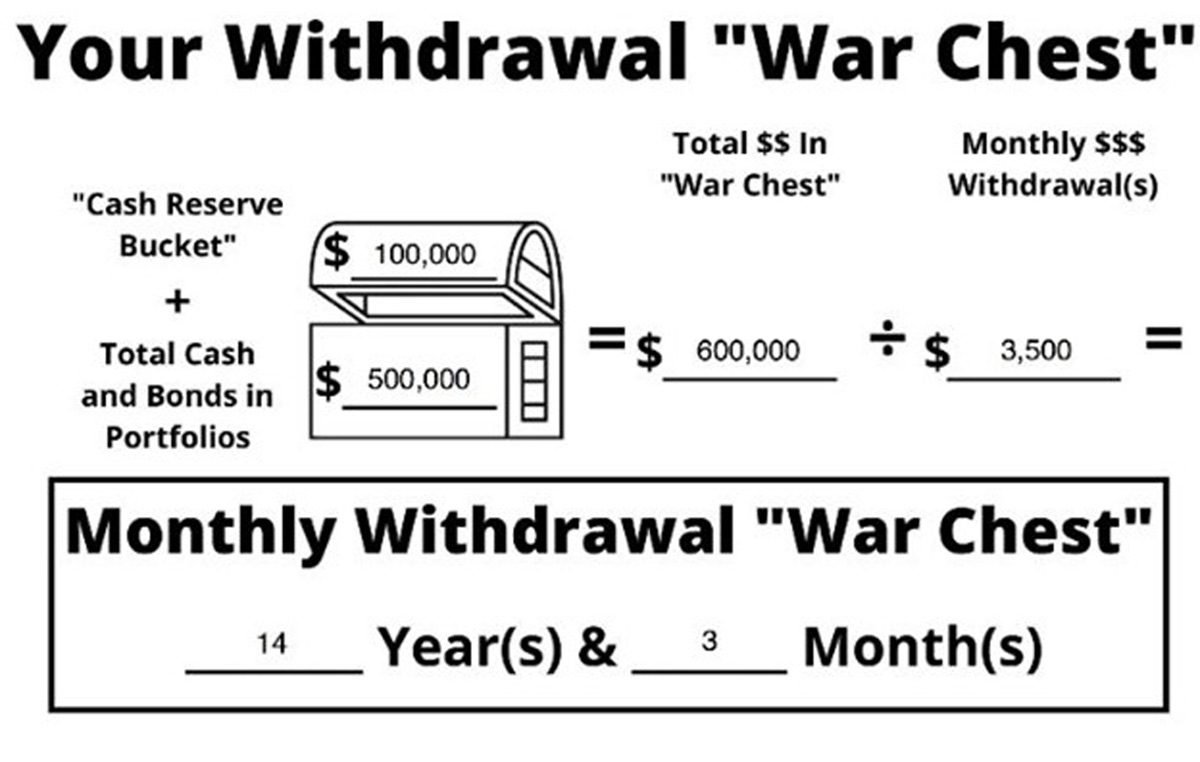Are You Going to Be OK in Retirement? 1 Easy Calculation Can Provide the Answer
Running out of money in retirement is a common fear, but knowing you have enough cash on hand to get through a severe stock market downturn can help. It’s a figure I call your “Withdrawal War Chest,” and it’s simple to calculate.


The stock market goes through recurring cycles that look to us like the four seasons. Fear is rarely apparent in spring or summer and barely palpable even in the fall. However, the “winter” portion of a stock market cycle is typically the harbinger of emotion-filled missteps by many investors.
“Am I going to be living under a bridge?” This is a “winter” question that I have often been asked over the past four decades, especially by prospective clients without a plan, even those with millions of investable dollars. This is because much of the “top of mind” space in our brain is allocated to thinking about our basic needs, including food, clothing, shelter, health care, transportation and education. When the stock market goes down, the reptilian, self-preservation portion of people’s brains often takes over, and they worry first and foremost about funding their basic needs.
The next and most important “winter” question I get asked is, “Am I going to be OK?” This is often due to a misperception that “something seems to be different this time.” Different in a potentially very bad way, more unusual than anything we’ve ever seen, and as a result, I may not be able to live and enjoy anywhere near the quality of life I had planned throughout retirement.

Sign up for Kiplinger’s Free E-Newsletters
Profit and prosper with the best of expert advice on investing, taxes, retirement, personal finance and more - straight to your e-mail.
Profit and prosper with the best of expert advice - straight to your e-mail.
At our firm, we have created a tool to provide clients with peace of mind showing them approximately how long they will be “OK.” I call this the “Withdrawal War Chest.” A war chest has historically been defined as a fund accumulated to finance a war, and recently, has expanded its meaning to a fund earmarked for a specific, challenging purpose. There are few financial endeavors more challenging than planning for retirement. Luckily, knowing your Withdrawal War Chest makes such planning much less stressful.
So how do you figure out your Withdrawal War Chest? Here’s our simple process:
- Add your total cash reserves AND total cash and bonds in your portfolios to get your War Chest.
- Divide your total War Chest by your monthly retirement withdrawal.
- That’s it.
This calculation provides an estimated time frame in which your War Chest (cash and bonds) alone could support your cash flow needs without withdrawing or selling a single penny from equities (stocks). To show you what that calculation could look like, let’s look at a hypothetical couple — John and Jane — who have a nice cash cushion saved up.

While the War Chest calculation is a simple one, its impact is tremendous. Your monthly Withdrawal War Chest is not only protection, but most importantly, peace of mind. Take John and Jane from our example above. They have 14 years and 3 months’ worth of withdrawals that is completely independent of the stock market. They don’t have to worry about it bouncing up, down or sideways. It’s just a quick snapshot, but it’s one that offers people confidence, because if the stock market goes through an extended “winter,” people are sure they can withstand it by not being forced to sell low.
The majority of people who liquidate most or all of their stocks while going through stock market downturns don’t have a plan and give in to fear. These types of emotional decisions often result in financial losses that are never recovered. This is not something you want to say when reflecting back on your life savings. While there is no magic wand to wave to take the emotions out of a decision, having a plan in place and knowing your Withdrawal War Chest can make those winter periods much less stressful.
Our typical retirement monthly Withdrawal War Chest has 10+ years of withdrawals. That being said, each individual household and family has their own unique needs. However, if you have a plan and know your Withdrawal War Chest, you can take a lot of anxiety out of investing and planning throughout retirement.
Disclaimer
This information is prepared by DiNuzzo Wealth Management, and all opinions are the judgment of author P.J. DiNuzzo, as of the date of publication and could be subject to change. This material is provided for educational purposes only and readers should not rely on the content as the only basis for investment or retirement decisions or advice. Always consult with your personal financial adviser and tax adviser before making any financial decisions.
Get Kiplinger Today newsletter — free
Profit and prosper with the best of Kiplinger's advice on investing, taxes, retirement, personal finance and much more. Delivered daily. Enter your email in the box and click Sign Me Up.

P.J. DiNuzzo, CFA, PFS, AIF, MBA, MSTX, is the founder, president and chief investment officer for DiNuzzo Private Wealth Inc./DiNuzzo Wealth Management in Beaver, PA. The firm has been helping pre-retirees and retirees make smart money and best-life choices for 31 years. P.J. is also the author of the book "The Seven Keys to Investing Success."
-
 What the Capital One Discover Merger Means for Your Wallet
What the Capital One Discover Merger Means for Your WalletThe Capital One Discover merger reshapes the credit card landscape and could impact your credit card rewards, interest rates and card perks.
By Paige Cerulli
-
 My Advice for Enrolling in Medicare Part B — Based on Experience
My Advice for Enrolling in Medicare Part B — Based on ExperienceEnrolling in Medicare is notoriously complicated and can result in penalties if you get the timing wrong. Here are some valuable tips for first-timers.
By Sandra Block
-
 Before You Invest Like a Politician, Consider This Dilemma
Before You Invest Like a Politician, Consider This DilemmaAs apps that track congressional stock trading become more popular, investors need to take into consideration some caveats.
By Ryan K. Snover, Investment Adviser Representative
-
 How to Put Together Your Personal Net Worth Statement
How to Put Together Your Personal Net Worth StatementNow that tax season is over for most of us, it's the perfect time to organize your assets and liabilities to assess your financial wellness.
By Denise McClain, JD, CPA
-
 Bouncing Back: New Tunes for Millennials Trying to Make It
Bouncing Back: New Tunes for Millennials Trying to Make ItAdele's mournful melodies kick off this generation's financial playlist, but with the right plan, Millennials can finish strong.
By Alvina Lo
-
 Early-Stage Startup Deals: How Do Convertible Notes Work?
Early-Stage Startup Deals: How Do Convertible Notes Work?Some angel investors support early startups by providing a loan in exchange for a convertible note, which includes annual interest and a maturity date.
By Murat Abdrakhmanov
-
 SRI Redefined: Going Beyond Socially Responsible Investing
SRI Redefined: Going Beyond Socially Responsible InvestingNow that climate change has progressed to a changed climate, sustainable investing needs to evolve to address new demands of resilience and innovation.
By Peter Krull, CSRIC®
-
 Here's When a Lack of Credit Card Debt Can Cause You Problems
Here's When a Lack of Credit Card Debt Can Cause You ProblemsUsually, getting a new credit card can be difficult if you have too much card debt, but this bank customer ran into an issue because he had no debt at all.
By H. Dennis Beaver, Esq.
-
 Going to College? How to Navigate the Financial Planning
Going to College? How to Navigate the Financial PlanningCollege decisions this year seem even more complex than usual, including determining whether a school is a 'financial fit.' Here's how to find your way.
By Chris Ebeling
-
 Financial Steps After a Loved One's Alzheimer's Diagnosis
Financial Steps After a Loved One's Alzheimer's DiagnosisIt's important to move fast on legal safeguards, estate planning and more while your loved one still has the capacity to make decisions.
By Thomas C. West, CLU®, ChFC®, AIF®